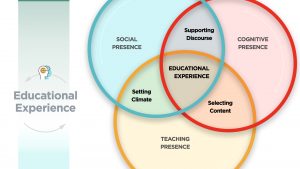Introduction: Pathways into Maximizing Student Engagement
The ‘Extra Edge’
With a single click on a meeting link, we can find ourselves on another side of the digital door. A door to a new session, a new experience, new challenges, and new learning opportunities in our online class. While we continually show required flexibility, there are many instances that still make us realize that we may need an ‘Extra Edge’ to make our teaching “really meaningful,” to help our students become more engaged and for helping ensure that the teaching and learning experiences are rich and effective! If you just nodded your head in agreement, then it’s time to explore ways to help you move forward.
From the Trenches…
The sustained transition to online teaching and learning has been challenging for some educators, as many of us are still trying to advance our digital skills and employ strategies for the new pedagogy that is required. The recent pandemic has also been very demanding for many students. Feelings of isolation, anxiety and other impacts can lead to low motivation levels. Student engagement, therefore, has become a prime concern for instructors, in making the online learning experience more meaningful.
Technology has provided us with the relevant tools and a myriad of resources have also been developed to support instructors in their endeavours. Sharing of screens, the use of video resources, better-designed user experiences, higher value discussions to name a few, have become a part of the new teaching landscape. Many instructors still often ponder the question “Were my students engaged?”
This resource is designed to provide insight into some of the deeper aspects of student engagement, thereby enabling you to achieve higher levels of participation and motivation in the digital classroom – an extra edge over existing practices. The course will comprehensively provide an evidence-based and research-based reservoir of examples, strategies, practical activities, and tools that have already created or are creating success stories in the field of engagement.
This resource can help you:
Type your key takeaways here.
- Identify and develop strategies that invite students to engage more with teaching and learning resources and encourage reflective analysis;
- Use facilitation skills to activate and deepen students’ intellectual curiosity and motivation;
- Apply strategies to ignite students’ communication and interaction with peers and instructors;
- Identify enriching educational experiences which contribute to enhanced engagement;
- Identify strategies to support collaborative learning and community building;
- Shape work-integrated experiences that strengthen student-industry relationships
Essentials of an Engaged Classroom
The research that guided the development of this course dates back to a 1999 seminal paper that proposed the idea of “Community of Inquiry” (CoI) as a framework for the optimal design of online teaching for a deep and meaningful learning experience (Garrison, Anderson & Archer, 1999). The framework highlights the importance of community by representing a process to support critical thinking, critical inquiry and discourse among students and teachers. The CoI model (Figure 1) proposes that the effectiveness of an educational experience depends upon three primary aspects:
- Cognitive presence: the extent to which learners are able to construct and confirm meaning through sustained reflection and discourse (Garrison, Anderson & Archer, 2001). Cognitive presence involves reflecting deeply on the course content, opening up to new ideas and developing new connections with the course material, exploring a problem and proposing solutions.
- Social presence is the ability of participants to project their individual personalities in order to identify and communicate with the community and develop inter-personal relationships. (Garrison, 2009). Social presence involves open communication, affective expression, and group cohesion.
- Teaching presence: is the design, facilitation, and direction of the social and cognitive processes for the purpose of realizing the relevant learning outcomes (Anderson, Rourke, Garrison, & Archer, 2001). Teaching presence involves guidance, building understanding and motivating students.

The intersection of these three elements represents a rich and meaningful experience for students. The instructor/teacher/facilitator establishes teaching presence by creating ample opportunities for interaction and feedback. Learner interaction fosters social presence and a sense of community and learners are more likely to engage in active processes that help in constructing new knowledge, therefore leading to their cognitive development.
The CoI framework has become the basis for a large number of studies and many researchers have been trying to modify or add more presences (Befus, 2016).
Pathways to Maximizing Engagement
With the CoI framework as the research pillar, this course is divided into four modules, each comprised of effective strategies proposed and practiced by experts, practical activities that have proved to be successful at engaging students, and relevant text, video and audio resources to support your practice.

